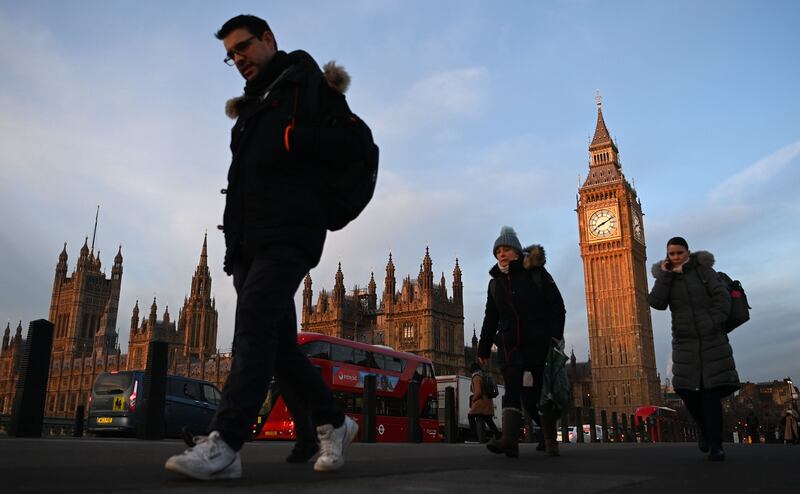A stallholder at Old Spitalfields Market in East London beckoned me over. Smiling, he placed a heavy little metal bowl in one of my hands and a short, chubby stick in the other. “Play it,” he said. How do you play a mortar and pestle?
He sensed my confusion. “It’s a Tibetan singing bowl. Take the puja and run it here,” he said, rolling the chubby stick around the rim. Sure enough, the bowl started singing. A melodic, undulating hum grew louder as the vibration increased.
I flipped the bowl over. It had a price tag of £173 (€195), a bit rich for a tiny bowl that could not hold half of a portion of cornflakes. Tourists must buy them, I mused.
“No, mostly locals. They buy them for their yoga and the healing and natural therapy,” the stallholder said. Off he went, smiling again and gesturing to another passerby.
READ MORE
[ British teachers turn up the heat as cold snap bitesOpens in new window ]
Any new arrival to Britain will notice the omnipresence of fretting about the cost-of-living crisis. In Ireland such talk is becoming a national sport, but in Britain it is truly Olympian. Each media outlet, all commentators and seemingly every conversation held in public is riddled with solemn intonation about the dwindling value of money. The nation is rapt by the price of everything.
British people seem genuinely fitful over their finances. With among the worst inflation of any developed nation and a dire economy with thin growth prospects, who could blame them? Britain’s self confidence is brittle at this moment.
Yet there are still plenty of locals buying Tibetan singing bowls at market stalls for the cost of a week’s food for a family of six. But this is London. The city is a bubble, afloat on its own importance. Its economics follow a trajectory distinct from the rest of Britain.
Its politics are as different as its economics. London voted overwhelmingly for Remain in the Brexit referendum, even as surrounding enclaves and the nation went for Leave. In the 2019 general election, Jeremy Corbyn’s Labour received one-and-a-half times the London vote share of the Tories, who had their biggest win nationally since 1935.

While London is different, it does not stay the same. The ongoing gentrification of its East End is an example of its constant shuffling in new directions. The eastward sprawl of wealthier liberals, who seem well insulated from the cost-of-living crisis, is writ large in its old markets. They are bubbles within a bubble.
Old Spitalfields has not been a traditional East End market for many years. Nobody here sells cheap household goods or pie and mash, although it is easy to find Italian porchetta or Turkish chicken sote. There remains a superficial desire for the old, rooted in nostalgia rather than tradition. The biggest queue on Sunday was for artisan desserts at Humble Crumble, which is “better than Nan’s”. Nan didn’t charge £8 per slice.
[ Solving UK strikes is not about ‘winning the argument’Opens in new window ]
A few hundred yards further east lies Brick Lane, for years the spiritual heart of London’s Bangladeshi community. It has morphed into a playground for middle-class hipsters who trickle down from the nearby technology hub of Shoreditch. Even its indoor food and vintage emporium is called Upmarket.
Crossing northeast through old council flats, now occupied by tech and city workers paying big rents, you reach the Columbia Road flower market. It is riotous explosion of unseasonal colour on a Sunday afternoon. The so-called “Hackney hipsters” (Columbia is in Tower Hamlets but Hackney is just up the road) are well ensconced here. The old buildings of the Guinness Trust, which built affordable housing for the working class in the 19th century, hints at the area’s blue collar provenance.
I heard working-class London accents here for the first time since starting my walk 40 minutes previously at Old Spitalfields. They came from the flower sellers. One of them told me that none of his colleagues were East End locals. He was from Guildford. Where have the people who lived here for generations gone, I asked. “They’ve all cashed in and moved to Southend,” he said.
Ten minutes further on takes you into Hackney proper, and the now-upscale Broadway Market. Locals fought gentrification here almost 20 years ago. In 2005, protesters famously occupied 34 Broadway Market after a local cafe owner was evicted. Today, it houses a branch of Planet Organic, a retail chain owned by a private equity company capitalising on the hipster economy.
Britain’s cost-of-living crisis will end, but parts of London will barely notice it anyway. The city keeps trundling on, doing into its own thing and morphing, as it has always done, along the way.















